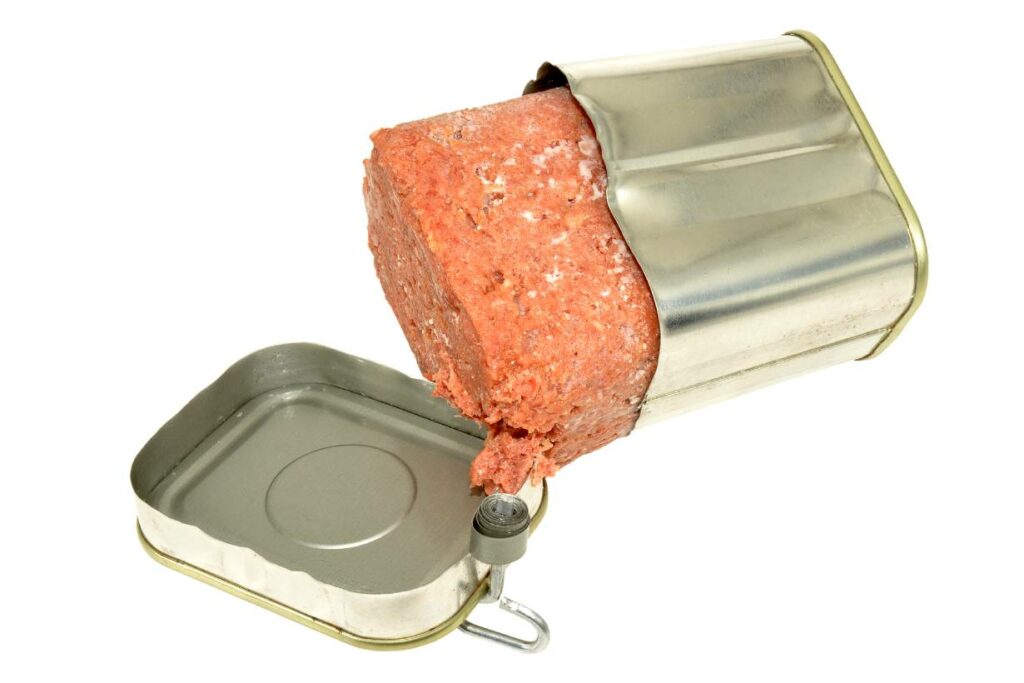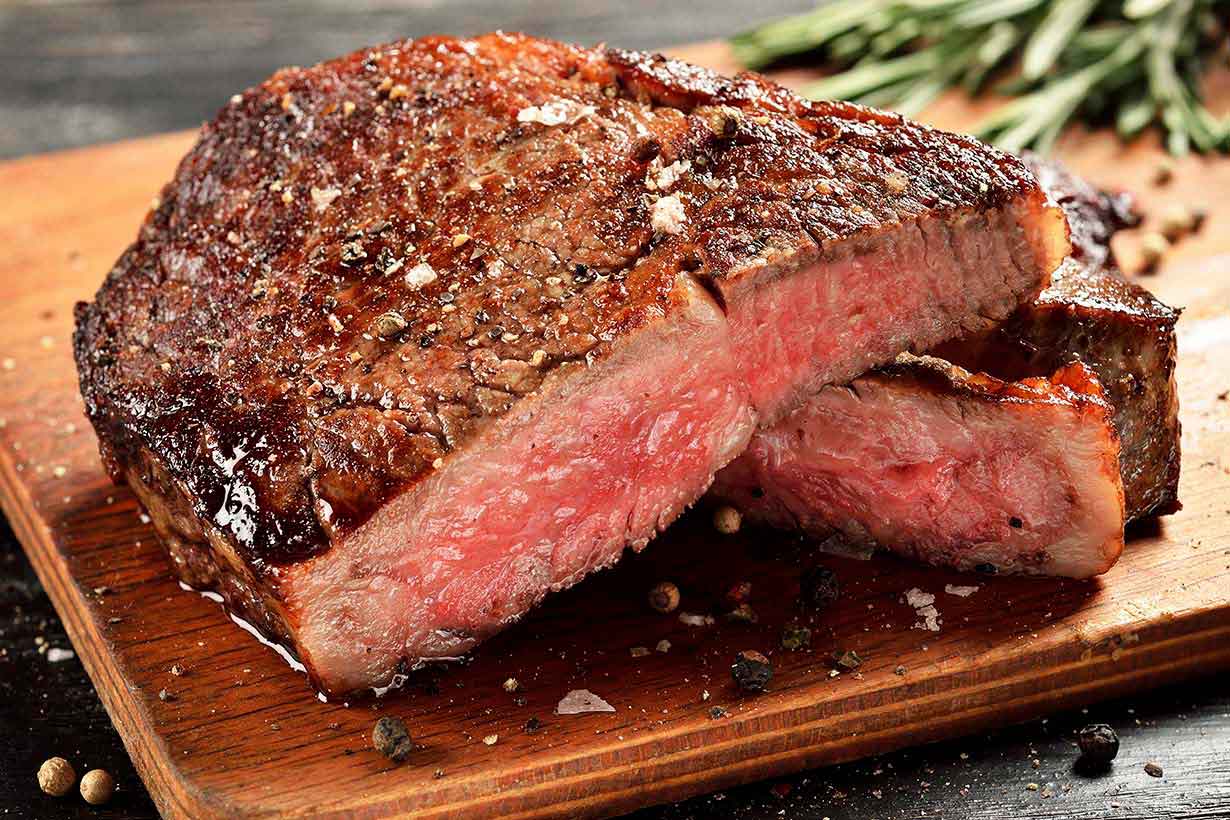Corned beef is a meat product made with beef.
But what exactly is it, what does it offer nutritionally, and is it a healthful choice?
This article examines the nutritional properties of corned beef, highlighting its benefits and potential downsides.

Table of contents
What Is Corned Beef?
The term ‘corned beef’ originates from the process of preserving meat by covering it with corns of salt.
A “corn of salt” is an old English expression, and in the present day, most people would use the term “grain of salt.”
Nevertheless, the name ‘corned beef’ has endured for centuries. The origins of corned beef are thought to coincide with the development of meat preservation via salt-curing (1).
Given its ability to be canned, commercial corned beef played a key role as a ration during World War I and World War II (2).
Types of Corned Beef
The term corned beef may refer to several distinct things:
- Salt-cured brisket: Salt-cured brisket, also known as corned beef, can be made at home or bought ready-cured. It is a fresh cut of beef brisket cured in a brine.
- Canned corned beef: Also typically made from brisket or similar cuts of beef, corned beef is pre-cooked, packaged in a can, and has a long shelf-life.
- Pre-cooked sliced corned beef: It is also possible to buy pre-cooked corned beef sold in deli-style slices.
Ingredients
Beef is the primary ingredient in corned beef products, typically comprising more than 98% of the product.
Canned corned beef contains the additional ingredients of salt and sodium nitrite. While not a standard ingredient, some products may also contain a small amount of sugar (3, 4).
In the case of freshly prepared salt-cured brisket, the ingredients may vary depending on the recipe or supplier. Salt is a pretty standard component of the brine, but it may also contain additional ingredients such as sugar, spices, and sodium nitrite.
The Nutritional Profile of Corned Beef
The following tables display the typical nutritional values of corned beef per 3.5 ounce (100-gram) serving.
All nutritional information has been sourced from the USDA’s FoodData Central database.
Daily values have been calculated using USDA data along with the FDA’s recommended daily values (5, 6).
| Name | Amount | % Daily Value |
|---|---|---|
| Calories | 250 kcal | |
| Carbohydrates | 0 g | 0% |
| Fiber | 0 g | 0% |
| Sugars | 0 g | |
| Fat | 14.9 g | 19.1% |
| Saturated | 6.18 g | 30.9% |
| Monounsaturated | 5.96 g | |
| Polyunsaturated | 0.63 g | |
| Omega-3 | 0.21 g | |
| Omega-6 | 0.42 g | |
| Protein | 27.1 g | 54.2% |
| Cholesterol | 96 mg | 32% |
Vitamins
| Vitamin | Amount | % Daily Value |
|---|---|---|
| Choline | 89.2 mg | 16.2% |
| Folate, DFE | 9 mcg | 2.3% |
| Vitamin A, RAE | 0 mcg | 0% |
| Vitamin B1 (thiamin) | 0.02 mg | 1.7% |
| Vitamin B2 (riboflavin) | 0.147 mg | 11.3% |
| Vitamin B3 (niacin) | 2.43 mg | 15.2% |
| Vitamin B5 (pantothenic acid) | 0.626 mg | 12.5% |
| Vitamin B6 | 0.13 mg | 7.6% |
| Vitamin B12 | 1.62 mcg | 67.5% |
| Vitamin C | 0 mg | 0% |
| Vitamin D | 0.2 mcg | 1% |
| Vitamin E | 0.15 mg | 1% |
| Vitamin K | 1.6 mcg | 1.3% |
Minerals
| Mineral | Amount | % Daily Value |
|---|---|---|
| Calcium | 12 mg | 0.9% |
| Copper | 0.064 mg | 7.1% |
| Iron | 2.08 mg | 11.6% |
| Magnesium | 14 mg | 3.3% |
| Manganese | 0.041 mg | 1.8% |
| Phosphorus | 111 mg | 8.9% |
| Potassium | 136 mg | 2.9% |
| Selenium | 42.9 mg | 78% |
| Sodium | 897 mg | 39% |
| Zinc | 3.57 mg | 32.5% |
Benefits
Corned beef has several benefits relating to its nutritional profile and characteristics.
High In Selenium and Vitamin B12
One of the first things to highlight about corned beef’s nutritional profile is its high content of selenium and vitamin B12.
In just a 3.5-ounce (100-gram) serving, corned beef provides over 78% of the recommended daily value for selenium. For vitamin B12, this same serving accounts for 68% of the daily value (5, 6).
Selenium, an essential mineral, is crucial for the manufacture of selenoproteins and various enzymes with antioxidant properties. Among their roles, these selenium-containing proteins and enzymes help to protect the body’s cells from free radical-induced damage (7, 8).
Vitamin B12 plays an important role in DNA production and, when correcting a B12 deficiency, helps to prevent anemia (9, 10).
Alongside B12 and selenium, corned beef also contains moderate quantities of vitamins B2, B3, B5, and B6, along with copper, iron, phosphorus, and zinc.
Convenient and Long Shelf-Life (when canned)
Regarding canned corned beef, this product offers both portability and is long-lasting.
Encased in sealed cans, canned corned beef products are easily transportable.
Additionally, with a lengthy shelf-life, they don’t require immediate consumption and can be stored at home for months in a cool and dry place.
The product label will provide further information on the ‘best before’ date.
In contrast, uncooked corned beef in brine has a comparatively shorter shelf life. According to the USDA, such products may be refrigerated for 5-7 days when unopened (11).
High Protein Content
Like all cuts of beef, corned beef contains high quantities of protein.
On average, 100 grams of cooked corned beef offers approximately 27.1 grams of protein (5).
Downsides
Considering its ingredient profile, there are certain potential drawbacks of corned beef to consider.
High Salt Content
Since corned beef is a salt-cured product, it is naturally high in salt.
Salt comprises approximately 40% sodium by weight (12).
Although sodium is an essential mineral for human health, excessive intake can lead to elevated blood pressure levels, thereby raising the risk of cardiovascular diseases (13, 14).
The Dietary Guidelines for Americans recommend that adults consume no more than 2,300 mg of sodium per day. Conversely, the American Heart Association recommends an “ideal limit” of no more than 1,500 mg per day (15, 16).
According to USDA data, corned beef typically contains 897 mg of sodium per 100 grams (5).
To highlight how much added salt this is, 100 grams of unprocessed beef brisket only has a sodium content of only 48 mg (17).
For further information on the sodium content of different types of beef, please refer to the guide below:
30 Types of Beef: Nutrition Facts For Every Cut
Contains Nitrate or Nitrite
Canned corned beef contains the preservatives sodium nitrate or sodium nitrite. Additionally, uncooked corned beef products may also contain these preservatives, depending on the ingredients used in the brine.
Sodium nitrate and nitrite are commonly used in processed meat as preservatives. This is not only because they help to preserve the meat and prevent bacterial spoilage, but they also enhance its flavor and give it the characteristic pink color associated with processed meats (18).
However, on the negative side, nitrate and nitrite can potentially react with amines, which are present in proteins, to form compounds called nitrosamines (19).
Numerous nitrosamines are recognized as carcinogenic (20).
On this note, several systematic reviews have demonstrated a correlation between high dietary intake of nitrate and nitrite and an increased risk of various cancers (21, 22, 23).
Individuals seeking to avoid sodium nitrate or nitrite should check the ingredients in uncooked corned beef products.
It is also possible to make a homemade nitrate-free corned beef.
Corned Beef Is a Processed Meat
Lastly, it’s worth noting that, alongside products like Spam and hot dogs, corned beef is categorized as a type of processed meat.
Numerous studies, including large systematic reviews of observational research, have demonstrated a link between processed meat intake and cardiovascular disease as well as all-cause mortality (24, 25).
Furthermore, the World Health Organization (WHO) classified processed meat as a ‘group 1 carcinogen’ in 2015. According to the WHO, this classification was given because there is “sufficient evidence from epidemiological studies that eating processed meat causes colorectal cancer” (26).
How Do People Use Corned Beef?
There are many ways in which people use corned beef.
Some popular ways to use it include:
- Sandwiches: Corned beef is a popular choice as a sandwich filling.
- Corned beef hash: This traditional dish features corned beef, cabbage, potatoes, and onions.
- Omelets: Corned beef is a common omelet ingredient.
- Tacos: Corned beef, along with vegetables and sauces such as hot sauce, salsa, or sour cream, can feature as an in ingredient in tacos.
- Soups and stews: Like any meat, corned beef can be an ingredient in soups and stews, particularly when combined with potatoes.
Does Corned Beef Need To Be Cooked?
A common question that comes up about corned beef is whether it requires cooking.
The answer depends on the type of corned beef.
Raw corned beef sold in a brine requires cooking and should be treated the same way as any other raw meat product.
However, canned corned beef or pre-cooked sliced products are ready to eat and do not need further cooking.
That said, some people like to cook canned corned beef and eat it as part of a dish. Canned corned beef can be cooked by adding it to soups and stews, or by pan-frying, grilling, roasting, or stir-frying.
Is Corned Beef a Healthy Choice?
Given the uncertainties surrounding the health effects of processed meat’s high sodium levels and preservative content, opting for unprocessed meat over products like corned beef is prudent.
However, this doesn’t mean that corned beef can’t be included in the diet from time to time.
As with any food, it is the dose and frequency of consumption that matters, as well as how it fits into the overall dietary pattern. In this regard, the Dietary Guidelines for Americans state that dietary patterns leading to positive health outcomes include “relatively lower consumption of processed meats” (27).
When consuming processed meats like corned beef, it is also worth remembering that there are measures we can take to limit the potential formation of nitrosamines.
For instance, ascorbic acid (vitamin C), and potentially polyphenols, may inhibit the conversion of nitrate and nitrite to nitrosamines (28, 29, 30, 31).
With this in mind, consuming corned beef alongside nutrient-rich vegetables would be a healthier option than corned beef on bread.
References
- https://www.foodandwine.com/news/complicated-irish-history-corned-beef
- https://www.warwickwarmemorial.org.uk/ww2-rationing-rules/
- https://fdc.nal.usda.gov/fdc-app.html#/food-details/2025253/nutrients
- https://www.princes.co.uk/our-products/meat/corned-beef/product-corned-beef/
- https://fdc.nal.usda.gov/fdc-app.html#/food-details/170602/nutrients
- https://www.fda.gov/food/new-nutrition-facts-label/daily-value-new-nutrition-and-supplement-facts-labels
- https://www.hsph.harvard.edu/nutritionsource/selenium/
- https://ods.od.nih.gov/factsheets/Selenium-Consumer/
- https://ods.od.nih.gov/factsheets/VitaminB12-Consumer/
- https://www.nhlbi.nih.gov/health/anemia/vitamin-b12-deficiency-anemia
- https://ask.usda.gov/s/article/How-long-can-you-store-corned-beef
- https://www.cdc.gov/salt/index.htm
- https://pubmed.ncbi.nlm.nih.gov/35246796/
- https://www.who.int/tools/elena/interventions/sodium-cvd-
- https://www.fda.gov/food/nutrition-education-resources-materials/sodium-your-diet
- https://www.heart.org/en/health-topics/high-blood-pressure/changes-you-can-make-to-manage-high-blood-pressure/shaking-the-salt-habit-to-lower-high-blood-pressure
- https://fdc.nal.usda.gov/fdc-app.html#/food-details/169488/nutrients
- https://www.ncbi.nlm.nih.gov/pmc/articles/PMC7464959/
- https://www.sciencedirect.com/topics/medicine-and-dentistry/nitrosamine
- https://www.efsa.europa.eu/en/news/nitrosamines-food-raise-health-concern
- https://academic.oup.com/ije/article/51/4/1106/6550543
- https://www.ncbi.nlm.nih.gov/pmc/articles/PMC8838348/
- https://pubmed.ncbi.nlm.nih.gov/36851064/
- https://jamanetwork.com/journals/jamainternalmedicine/fullarticle/2759737
- https://www.sciencedirect.com/science/article/pii/S2161831322013126
- https://www.who.int/news-room/questions-and-answers/item/cancer-carcinogenicity-of-the-consumption-of-red-meat-and-processed-meat
- https://www.dietaryguidelines.gov/sites/default/files/2020-12/Dietary_Guidelines_for_Americans_2020-2025.pdf
- https://pubmed.ncbi.nlm.nih.gov/2507690/
- https://www.ncbi.nlm.nih.gov/pmc/articles/PMC7139399/
- https://pubmed.ncbi.nlm.nih.gov/16413414/
- https://pubmed.ncbi.nlm.nih.gov/38436057/








